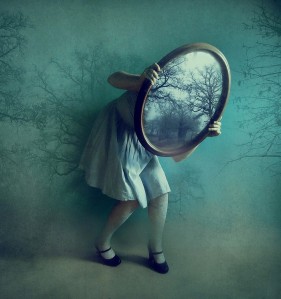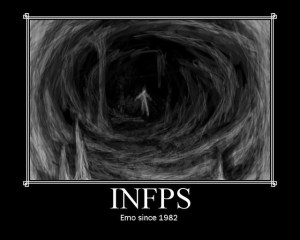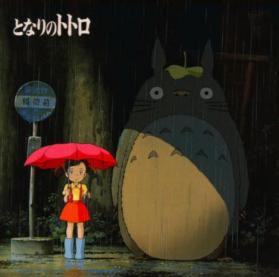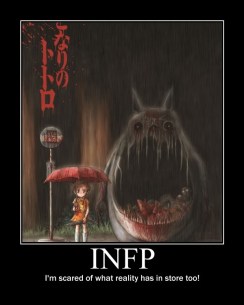The INFP Curse
Leave a commentMarch 3, 2013 by nextsimulacrum
Have you ever heard of the Myers-Briggs Type Indicator (MBTI) assessment? It’s a questionnaire, meant to measure psychological preferences in how people perceive the world, which was published in 1962 by Katharine Cook Briggs and her daughter Isabel Briggs Myers. It’s based on the typological theories about people’s psychological types, proposed by Carl Jung: Briggs and Myers wished to turn Jung’s theory to practical use. They started developing the MBTI during the World War II, believing that it could help to find best work places for women, taking up industrial jobs.
According to Jung, there are four principal psychological functions by which people experience the world: sensation, intuition, feeling, and thinking. Based on this, the MBTI sorts psychological differences into four opposite pairs known as dichotomies, it means 16 possible psychological types: Extroversion(E)-Introversion(I); Sensing(S)-Intuition(N) Thinking(t)-Feeling(F); Judging(J)-Perception(P).
I’ve tried this test a few years ago and found its results really interesting. The MBTI isn’t regarded as a highly reliable assessment (actually, are any of them?), however it is likely to show some tendencies that are more or less applicable to a person who’s taken it.
What I remember well from the MBTI is the description of a psychological type called INFP (this stands for introversion, intuition, feeling and perception. Hmm, it looks like this kind of person barely has any touch with the “real world”, doesn’t it?). The MBTI descriptions are pretty detailed, but to put it shortly INFPs are described as eternal  idealists, who always need to have a “cause” to work and fight for, but the world is never as they want it to be. Also, they lack of order in their lives, tend to over-analyze other people and imagine things that aren’t actually true. As a result, you could say that they live in their own reality, a (yes I know I’m exaggerating) distorted projection of the world, where everything that actually concerns them is exaggerated and painted in dark colours. Or black and white.
idealists, who always need to have a “cause” to work and fight for, but the world is never as they want it to be. Also, they lack of order in their lives, tend to over-analyze other people and imagine things that aren’t actually true. As a result, you could say that they live in their own reality, a (yes I know I’m exaggerating) distorted projection of the world, where everything that actually concerns them is exaggerated and painted in dark colours. Or black and white.
There are many ways psychologists and psychoanalysts try to measure types of different personalities, however, it is a fact that there is a considerable amount of people who never seem to be happy. They might be pretty content with their lives, but they still don’t feel fulfilled in one way or another, and often it seems that they don’t even want to get out of this situation. It seems that they secretly enjoy this chronic psychological suffering; it looks like an honourable thing, which makes you more interesting and more deep than these happy people around you.
Of course, they would never admit it. Of course they want to be happy and it’s not the life-style they desire, they just can’t help it. But is it actually true? After all they would probably agree with Ernest Hemingway, who said: “Happiness in intelligent people is the rarest thing I know”. So, this is what, after reading the before-metioned description, I jokingly called the “INFP curse”: it looks like a vicious cycle that people simultaneously want and do not want to escape.
These are people who do not fear of a dystopian world, they live in a dystopian world. They have created their own simulacra which are simulating that they are living in a simulacrum. Should they all be into dystopia? Maybe you don’t actually need a fictional one when you already live in one of your own.


